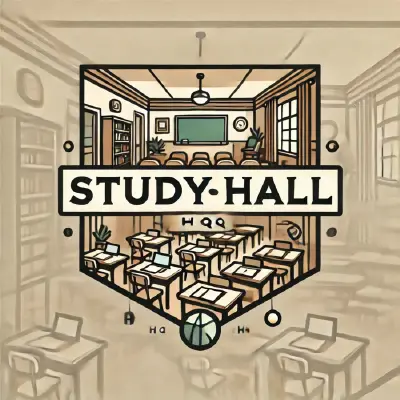
Study Hall HQ
222 episodes Last Updated: May 15, 25
Welcome to Study Hall HQ! Our mission is to make understanding complex documents easier and more accessible. We take dense, complicated texts—such as legal documents, bills, indictments, and more—and break them down using innovative tools like Google's NotebookLM. By utilizing the Audio Overview feature, we simplify the information, turning it into clear, digestible content so you can grasp the key points without all the confusion. Subscribe and join the conversation!
Episodes
May 15, 2025
But Why, Though: Why Colors Became Gendered
This document explores the cultural construction of gender through color, revealing how pink came to be associated with girls and blue with boys. Drawing on historical shifts in marketing, fashion, and social norms, it uncovers how these color codes emerged—not from inherent preferences, but from strategic branding and societal influences. The analysis also critiques the ongoing impact of these gendered color norms on childhood development and identity formation.
This deep-dive explores the legendary “Got Milk?” campaign of the 1990s, dissecting how a simple two-word slogan became a cultural touchstone and a marketing masterstroke. Discover how the campaign used emotional triggers like deprivation, nostalgia, and celebrity endorsements to reshape public perception of milk and reinvigorate the struggling dairy industry. This comprehensive analysis uncovers the ad strategy, societal impact, economic outcomes, and ethical questions that made “Got Milk?” one of the most memorable campaigns in American advertising history.
This comprehensive essay explores the creation, symbolism, and cultural legacy of American Gothic (1930) by Grant Wood, one of America's most iconic paintings. It examines how Wood’s European artistic influences, his Midwestern upbringing, and the turbulent context of the Great Depression shaped the painting’s ambiguous tone. The essay delves into visual analysis, societal interpretations over decades, and the painting’s profound impact on American identity and pop culture. From parodies to political cartoons, American Gothic evolved from a regional tribute to a national mirror reflecting America's enduring tensions between tradition and change.
Christian Discourses (1848) by Søren Kierkegaard explores the paradoxes of Christian faith, arguing that suffering, poverty, and hardship are not obstacles but pathways to spiritual richness and eternal hope. Divided into four parts, Kierkegaard moves readers from the worries of paganism to the inward, often painful, journey of genuine Christian life. Drawing from biblical passages like Matthew 6:24-34, he contrasts temporal struggles with eternal blessings, emphasizing self-denial, adversity as prosperity, and faith’s offensive nature in a complacent world. Written during a year Kierkegaard called his most fruitful, this profound work challenges believers to experience their faith deeply and personally.
May 08, 2025
But Why, Though: How Soap Changed Your Life
This in-depth narrative explores how Lever Brothers’ Lifebuoy soap campaign transformed global hygiene habits, making daily showering a cultural norm. Through powerful marketing tactics that blended fear, science, and morality, the campaign reframed body odor as a social disaster and cleanliness as a civic virtue. It traces Lifebuoy's evolution from germ-fighting “health soap” to a globally endorsed hygiene icon, examining its colonial reach, celebrity partnerships, and lasting impact on consumer behavior and public health. This essay reveals how advertising shaped not only hygiene habits but modern identity.
Trump Media & Technology Group Corp. (TMTG), the parent company of Truth Social, presents itself as a politically aligned media disruptor but operates without a revenue model, product pipeline, or infrastructure typically expected from a public tech firm. Despite holding $777 million in cash from a 2024 SPAC merger, the company faces numerous red flags: massive insider compensation and stock selling, minimal operational updates, and opaque governance bolstered by a move to Florida incorporation. With conceptual-only products like Truth+ and Truth.Fi, and full reliance on Donald Trump's brand visibility, TMTG exemplifies high-risk speculative investing driven more by ideology than fundamentals.
May 06, 2025
But Why, Though: Coffee Is Your Identity
This essay explores how coffee has evolved far beyond its function as a beverage into a powerful symbol of modern lifestyle, identity, and culture. Tracing its journey from Middle Eastern coffeehouses to third-wave cafés, the piece examines how media, branding, globalization, and urban development turned coffee into a communal ritual and personal brand. It also discusses the cultural weight of coffee in shaping social interactions, work habits, and neighborhood development—ultimately showing how coffee became a way of life.
The document is an essay that explores the life and work of Belgian surrealist painter René Magritte. It provides a detailed account of his early life, the influences that shaped his artistic style, and the development of his career. The essay highlights key recurring motifs in Magritte's work, such as bowler hats, apples, and mirrors, and examines his exploration of the tension between reality and illusion, as well as his challenges with financial hardship and conflict within the Surrealist movement. It concludes with an analysis of Magritte's enduring legacy and his impact on Pop Art, Conceptual Art, and popular culture.
Streamlining Permits with Smart Tech This Presidential Memorandum, issued April 15, 2025, aims to overhaul the outdated federal environmental permitting process by embracing 21st-century technology. Through digital transformation, interagency data sharing, and the creation of a Permitting Innovation Center, the policy promises faster project approvals and greater transparency. However, critics warn of risks including reduced public engagement, legal challenges, and over-reliance on untested tech infrastructure. Balancing innovation with accountability is central to its success.
Your Federal Job Just Got RiskierThis executive order, signed April 24, 2025, reshapes how federal employees earn permanent status by requiring agencies to affirmatively certify that continued employment serves the public interest. While the administration argues it ensures accountability and high performance, critics warn it invites politicization, weakens due process, and undermines morale. This controversial shift alters the landscape of civil service protections and could have sweeping implications for federal hiring and retention.